螯虾棕色脂肪组织在寒冷适应过程中的适应性产热作用
IF 1.4
4区 生物学
Q2 ZOOLOGY
引用次数: 0
摘要
为了研究低温对切弗里耶氏田鼠(Apodemus chevrieri)体重、产热活性和棕色脂肪组织(BAT)中解偶联蛋白-1(UCP1)含量的影响,我们使用了 50 只体重相近的健康成年小鼠进行实验。它们被分为以下五组,每组十只:对照组(0 d),动物在 25 ± 1°C 和 12L:12D (光:暗,08:00 开灯)光周期下饲养;其他组分别在 5 ± 1°C 和 12L:12D 光周期下饲养 7 d、14 d、21 d 和 28 d。实验结束后,测定了体重、静息代谢率(RMR)、非颤抖性产热(NST)、BAT质量、线粒体蛋白(MP)含量、细胞色素c氧化酶(COX)活性和UCP1含量的变化。结果表明,与对照组(0 d)相比,冷适应组的体重明显下降。相比之下,冷适应组的 RMR、NST、BAT 质量、MP 含量、COX 活性和 UCP1 含量明显增加。冷适应 28 天后,RMR 增加了 89.4%,NST 增加了 50.4%,BAT 质量增加了 44.6%,UCP1 含量增加了 36.0%。7 天后,(NST - RMR)/RMR 的比率为 1.03,第 21 天降至 0.59,此后保持稳定。可见,NST与BAT质量和UCP1含量呈显著正相关。结果表明,在持续低温条件下,螯虾能采取适当措施降低体重、提高RMR、诱导BAT组织增殖和UCP1表达失调,从而增强BAT的产热活性,以应对低温环境。在低温适应的早期阶段,NST在产热中占主导地位,但随着时间的推移,NST的作用逐渐减弱。这可能是源于北方、向南扩散到横断山区的小型啮齿类动物的一种独特的能量适应策略。本文章由计算机程序翻译,如有差异,请以英文原文为准。
Adaptive thermogenesis of the brown adipose tissue in Apodemus chevrieri during cold acclimation
To investigate the effect of low temperature on body mass, thermogenic activity, and Uncoupling protein-1 (UCP1) content of brown adipose tissue (BAT) in Chevrier’s field mouse (Apodemus chevrieri), 50 healthy adult mice with similar body mass were used in our experiment. They were divided into five groups of ten individuals as follows: a control group (0 d), where animals were maintained under 25 ± 1°C and a 12L:12D (light:dark, lights on 08:00) photoperiod; the other groups were maintained under 5 ± 1°C and a 12L:12D photoperiod for 7 d, 14 d, 21 d and 28 d, respectively. At the end of the experiment, the changes in body mass, resting metabolic rate (RMR), nonshivering thermogenesis (NST), BAT mass, mitochondrial protein (MP) content, cytochrome c oxidase (COX) activity, and UCP1 content were measured. The results showed that compared with the control group (0 d), the body mass of the cold acclimation groups decreased significantly. In contrast, RMR, NST, BAT mass, MP content, COX activity, and UCP1 content of the cold acclimation group increased significantly. After cold acclimation for 28 days, RMR increased by 89.4%, NST increased by 50.4%, BAT mass increased by 44.6%, and UCP1 content increased by 36.0%. The ratio of (NST − RMR)/RMR was 1.03 after seven days and then dropped to 0.59 on day 21, and remained at a steady level thereafter. Evidently, NST was significantly positively correlated with BAT mass and UCP1 content. The results indicated that under continuous cold exposure, A. chevrieri could take appropriate measures to reduce body mass, increase RMR, induce BAT tissue proliferation, and unregulated UCP1 expression, thereby enhancing BAT thermogenic activity to cope with a low-temperature environment. In the early stage of cold acclimation, NST was dominant in thermogenesis, but as time continued, it reduced. This may represent a unique energy adaptation strategy of small rodents originating from the north and spreading southward toward the Hengduan Mountain regions.
求助全文
通过发布文献求助,成功后即可免费获取论文全文。
去求助
来源期刊

Animal Biology
生物-动物学
CiteScore
2.10
自引率
0.00%
发文量
34
审稿时长
3 months
期刊介绍:
Animal Biology publishes high quality papers and focuses on integration of the various disciplines within the broad field of zoology. These disciplines include behaviour, developmental biology, ecology, endocrinology, evolutionary biology, genomics, morphology, neurobiology, physiology, systematics and theoretical biology. Purely descriptive papers will not be considered for publication.
Animal Biology is the official journal of the Royal Dutch Zoological Society since its foundation in 1872. The journal was initially called Archives Néerlandaises de Zoologie, which was changed in 1952 to Netherlands Journal of Zoology, the current name was established in 2003.
 求助内容:
求助内容: 应助结果提醒方式:
应助结果提醒方式:


